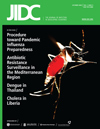Antimicrobial susceptibility of select respiratory tract pathogens in Dakar, Senegal
DOI:
https://doi.org/10.3855/jidc.20Keywords:
Haemophilus influenzae, Moraxella catarrhalis, Streptococcus pneumoniae, Streptococcus pyogenes, susceptibility.Abstract
Background : Haemophilus influenzae, Moraxella catarrhalis, Streptococcus pyogenes, and Streptococcus pneumoniae are the most common causative agents of respiratory tract infections (RTIs). The increase in resistance to current antibacterial agents highlights the need to monitor the resistance pattern of these bacterial pathogens.
Methodology: In this study, we assessed the antibacterial susceptibility of these pathogens causing respiratory tract infections in Dakar, Senegal, during 2007-2008. A total of 290 bacterial isolates (75 H. influenzae, 10 M. catarrhalis, 105 S. pneumoniae, and 100 S. pyogenes) were collected.
Results and Conclusions: All H. influenzae isolates were susceptible to amoxicillin/clavulanic acid, ofloxacin, clarithromycin, cephalosporins, and macrolides. Overall, 26.7% of H. influenzae isolates were completely resistant to ampicillin. Among the M. catarrhalis isolates, 30% were resistant to ampicillin. All the isolates of H. influenzae and M. catarrhalis that were resistant to ampicillin were beta-lactamase producing strains. Among the S. pneumoniae isolates, 33.3% isolates exhibited intermediate susceptibility to penicillin G, and one isolate was completely resistant. All five isolates that were resistant to erythromycin expressed the M phenotype. S. pyogenes exhibited high susceptibility to all other antibiotics, except tetracycline. Our study suggests that except for M. catarrhalis, all other bacterial isolates are susceptible to cephalosporins, macrolides, and fluroquinolones.
Downloads
Published
How to Cite
Issue
Section
License
Authors who publish with this journal agree to the following terms:
- Authors retain copyright and grant the journal right of first publication with the work simultaneously licensed under a Creative Commons Attribution License that allows others to share the work with an acknowledgement of the work's authorship and initial publication in this journal.
- Authors are able to enter into separate, additional contractual arrangements for the non-exclusive distribution of the journal's published version of the work (e.g., post it to an institutional repository or publish it in a book), with an acknowledgement of its initial publication in this journal.
- Authors are permitted and encouraged to post their work online (e.g., in institutional repositories or on their website) prior to and during the submission process, as it can lead to productive exchanges, as well as earlier and greater citation of published work (See The Effect of Open Access).








